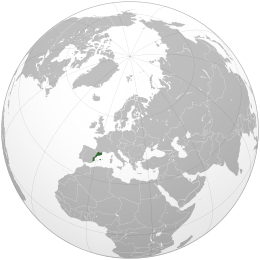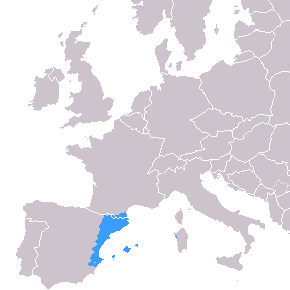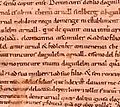Catalan language facts for kids
Quick facts for kids Catalan |
||||
|---|---|---|---|---|
| català | ||||
| Pronunciation | (EC) ~ (WC) | |||
| Native to | Andorra, France, Italy, Spain | |||
| Region | See geographic distribution of Catalan | |||
| Ethnicity | Catalan people | |||
| Native speakers | 11.5 million (2009) | |||
| Language family |
Indo-European
|
|||
| Standard forms |
Catalan (regulated by the IEC)
Valencian (regulated by the AVL)
|
|||
| Writing system | Latin (Catalan alphabet) | |||
| Official status | ||||
| Official language in | Latin Union
|
|||
| Recognised minority language in |
|
|||
| Regulated by | Institut d'Estudis Catalans Acadèmia Valenciana de la Llengua |
|||
| Linguasphere | 51-AAA-e | |||
 |
||||
|
||||
Catalan is a fascinating Romance language. It's part of the same language family as Spanish, French, and Italian. You'll find it spoken in several places, mainly in parts of Spain.
These areas include Catalonia, the Valencian Community, the Balearic Islands, and the eastern part of Aragon. A small area of Murcia also speaks it. Beyond Spain, Catalan is the official language of Andorra, a small country in the Pyrenees mountains. It's also spoken in North Catalonia in France and in the Italian city of L'Alguer. All these places are sometimes called the Catalan Countries.
The language most similar to Catalan is Occitan. It also shares some sounds and words with Spanish, Italian, French, and Portuguese.
Around 6 million people speak Catalan as their first language. About 10 million people can speak Catalan in total. This makes it the 6th most spoken Romance language. It is also the most spoken language in the European Union that is not an official language of the EU itself.
Images for kids
-
Catalan Countries (Països Catalans): (In orange, strict Catalan-speaking area) NE modern Spain (Catalonia, Valencian Community and Balearic Islands), SE. France (Roussillon, touching the Pyrenees) and Comune of Alghero (NW coast of Sardinia, an island belonging to Italy)
-
Homilies d'Organyà (12th century)
-
Fragment of the Greuges de Guitard Isarn (ca. 1080–1095), one of the earliest texts written almost completely in Catalan, predating the famous Homilies d'Organyà by a century
-
Billboard in Barcelona (detail), showing the word il·lusió ("illusion")
-
Sign in the town square of Begur, Catalonia, Spain. In plaça de la vila (literally "square of the town"), since the noun vila ("town") is feminine singular, the definite article carries the corresponding form, la ("the").
See also
 In Spanish: Idioma catalán para niños
In Spanish: Idioma catalán para niños












